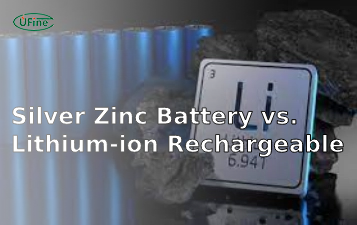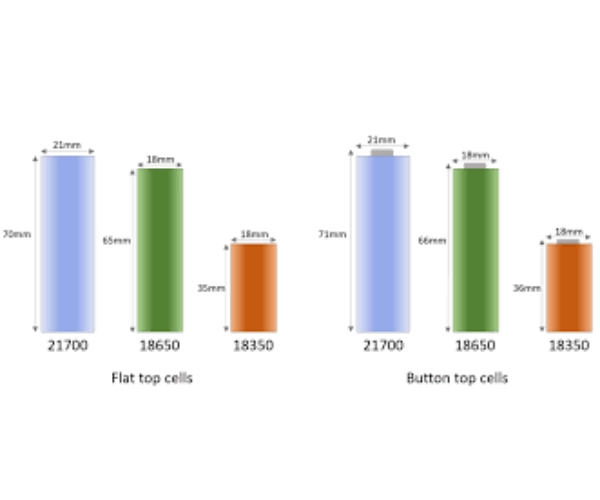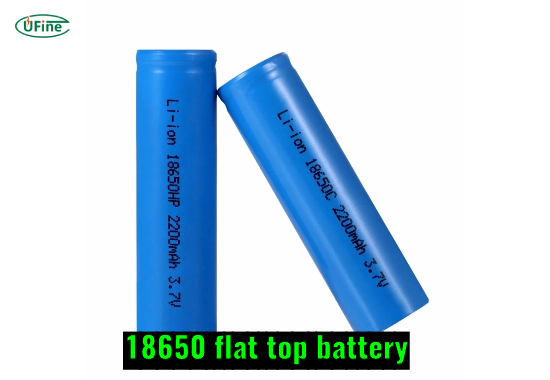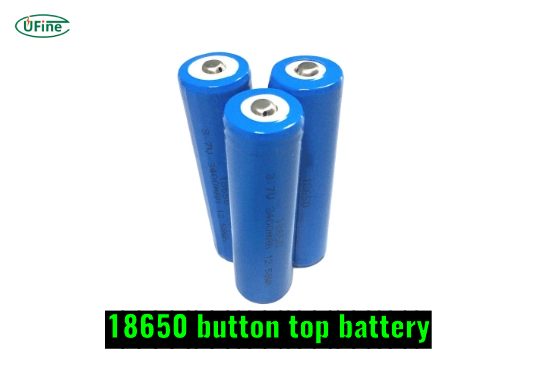
- Part 1. What is a 18650 flat top battery, and why choose it?
- Part 2. What is a 18650 button top battery, and why choose it?
- Part 3. Differences between flat top and button top 18650 batteries
- Part 4. How to choose between a flat top and a button top?
- Part 5. FAQs about 18650 flat top battery and button-top
Among rechargeable battery options, the 18650 battery stands out as one of the most versatile and widely used power sources. The choice between 18650 flat-top battery and button-top variants often puzzles users, as each design serves different purposes. This guide provides a detailed comparison of both types, covering their technical specifications, performance differences, and ideal applications to help you select the perfect battery for your device.
Part 1. What is a 18650 flat top battery, and why choose it?
A flat-top 18650 battery is a cylindrical lithium-ion battery with a flat positive terminal. It lacks the protruding button found on the positive end of the battery. The flat top design allows for a more compact form factor, making it suitable for devices with tight battery compartments.
18650 Flat Top Battery Pros&Cons
Flat Top Batteries Pros:
- Compact Size: The absence of a protruding button makes flat top 18650 batteries more compact, enabling them to fit into devices with limited space.
- Versatility: Flat-top batteries are compatible with a wide range of devices that require 18650 batteries, including flashlights, vaporizers, and power tools.
- Enhanced Safety: The flat design reduces the risk of accidental short-circuits when inserting or removing the battery from the device.
Best Uses for 18650 Flat Top Battery
- LED Flashlights with tight battery tubes
- Laptop battery packs (series configurations)
- Portable power banks
- RC devices requiring low-profile cells
Flat Top Batteries Cons:
- Limited Compatibility: Some devices, particularly those designed to accommodate button-top batteries, may require compatibility with flat-top variants. The absence of a button can prevent proper electrical contact in such cases.
- Lower Capacity: Due to their compact size, flat-top batteries may have slightly lower capacity than their button-top counterparts. This means they may provide somewhat less runtime in specific devices.
Technical Specifications of 18650 Flat Top Battery
- Diameter: 18mm ± 0.5mm
- Height: 65mm (without protection circuit)
- Nominal Voltage: 3.6V-3.7V
- Capacity Range: 2000mAh-3500mAh
- Discharge Rate: 10A-35A continuous
Part 2. What is a 18650 button top battery, and why choose it?
As the name suggests, a button top 18650 battery features a protruding button on the positive end of the battery. Many often refer to this design as a raised or protruding positive terminal.
18650 Button Top Battery Pros&Cons
Button Top Batteries Pros:
- Compatibility: Button-top batteries are designed specifically for devices that accommodate this type of battery. They ensure proper electrical contact, particularly in devices with spring-loaded battery compartments.
- Higher Capacity: Button-top batteries often have a higher capacity than flat-top variants. This means they can provide longer runtime in devices with high power consumption.
Button Top Batteries Cons:
- Size Limitations: The protruding button design makes button-top batteries slightly more significant than their flat-top counterparts. This can be a limitation in devices with tight battery compartments.
- Potential Short-Circuit Risk: The raised button increases the risk of accidental short circuits if the battery comes into contact with conductive materials when not in use or during storage.
Part 3. Differences between flat top and button top 18650 batteries
The two main 18650 battery types—flat top and button top—offer distinct features that affect device compatibility and performance.
Dimensions:
- Flat top 18650 batteries have a flat positive terminal, which means the positive terminal is flush with the top of the battery.
- Button top 18650 batteries feature a protruding positive terminal resembling a small button on top of the battery.
Compatibility:
- People commonly use flat-top batteries in devices with spring-loaded or sliding battery compartments that accommodate flat terminals.
- Users prefer button-top batteries for devices with fixed or rigid battery compartments explicitly designed for button-top terminals.
Contact Surface:
- The flat-top battery design of the positive terminal may provide a larger contact surface area in some devices, potentially improving connectivity.
- The positive terminal’s protruding button top ensures direct contact with the battery contacts in devices with recessed or limited battery compartments.
Device Suitability:
- Devices with flexible battery compartments and those designed for flat-top batteries are suitable for flat-top 18650 batteries.
- Devices with fixed or specialized battery compartments, particularly those requiring button-top batteries, are compatible with button-top 18650 batteries.
Handling:
- Flat-top batteries may be easier to handle and insert into devices with spacious or open battery compartments due to their flat profile.
- Button-top batteries are advantageous for devices with specific battery compartment designs, as the protruding terminal aids in alignment and insertion.
Application:
- Flat-top batteries are versatile and widely used in various electronic devices, including flashlights, laptops, and electric vehicles.
- Users prefer button-top batteries for devices that require a protruding positive terminal, such as flashlights and certain vaping devices.
Design:
- The flat design of flat-top batteries may provide a sleek and uniform appearance when installed in compatible devices.
- The button-shaped terminal of button-top batteries adds a distinctive feature to devices designed to accommodate them, enhancing aesthetics in some cases.
| Feature | Flat Top | Button Top | Recommended Use Cases |
|---|---|---|---|
| Height | 65mm | 69mm | Flashlights (e.g., Samsung 30Q flat top) |
| Max Discharge | 15A-25A | 20A-35A | Vape mods (e.g., Molicel P26A button top) |
| Terminal Design | Flat surface | Protruding button | Multi-battery devices (e.g., Nitecore EC4GS) |
When deciding between a flat-top battery vs button-top, understanding their unique characteristics will help you choose the best option for your device.
Part 4. How to choose between a flat top and a button top?
When purchasing 18650 batteries, consider factors such as device compatibility, space constraints, and power requirements.
Device Compatibility
Determine whether your device requires a specific type of battery. Some devices may explicitly state their compatibility requirements or have physical limitations that require flat-top or button-top batteries.
Space Constraints
Assess the available space within your device’s battery compartment. A flat-top battery may be a better fit if it has limited space. However, a button-top battery can provide higher capacity and longer runtime if space is not a concern.
Power Requirements
Consider the power demands of your device. A button-top battery with a higher capacity may be more suitable if it requires high power consumption. For devices with lower power demands, a flat-top battery should suffice.
Power Demand Examples
- Low Power (5-10W): LED flashlights, remote controls → Recommend Flat Top
- Medium Power (10-20W): Vape pens, digital cameras → Recommend Button Top
- High Power (20W+): Drones, power tools → Must Button Top
Safety
Evaluate the safety implications of each design. Flat-top batteries reduce the risk of accidental short-circuits. In contrast, button-top batteries may be more prone to such incidents if not stored properly.
Conclusion
The choice between flat-top and button-top 18650 batteries depends on device compatibility, space constraints, power demands, and safety considerations. Flat-top batteries offer versatility and compact size, while button-top batteries provide better compatibility with specific devices and higher capacity for sustained high-power output. To make an informed decision when purchasing 18650 batteries, carefully weigh the pros and cons of each battery type.
3-Step Battery Selection Checklist
- Measure Device Compartment
Required clearances: A flat top needs a height of≥65mm, while a button top requires a height of≥69mm. - Verify Contact Type
Spring-loaded contacts accept both types, fixed contacts require an exact match. - Check Discharge Needs
High-drain devices (>15A) demand button tops (e.g., LG HG2 button top)
Part 5. FAQs about 18650 flat top battery and button-top
Why choose a 18650 flat top battery for flashlights?
The 18650 flat top battery’s 65mm height fits standard flashlight tubes perfectly. Its recessed terminal prevents accidental activation, like in Fenix PD36R flashlights.
Can I convert a flat-top battery to a button-top battery?
No, adding external buttons voids safety certifications. Use spacers only for non-critical devices, such as LED lamps.
Do flat-top batteries last longer?
Typically, 5-10% shorter lifespan due to higher internal resistance. Quality flat tops, such as the Sony VTC6, still deliver over 500 cycles.
Are button-top batteries safer?
Yes, for high-drain devices. The physical button ensures stable contact, reducing arcing risks in mods with a power output of over 50W.
Related Tags:
More Articles

What is the Difference Between Silver Zinc Battery vs. Lithium-ion Rechargeable?
Compare silver zinc and lithium-ion rechargeable batteries: energy density, cycle life, safety, cost, and uses in drones, medical devices, EVs, and electronics.
What are Watts and Watt Hours in Battery?
Understand watt vs watt-hour in batteries: key differences, how to calculate capacity, and why they matter. Includes free comparison table.
Best 10 Blood Pressure Monitor Battery Review: Finding the Most Reliable
Are you looking for a reliable Blood Pressure Monitor battery? Here is a complete guide with the top 10 best blood pressure monitor batteries.
Bluetooth Headphone Battery Guide: All You Need to Know
Maximize headphone battery life with expert tips! Learn how to charge, check, troubleshoot, and choose the best bluetooth headphone battery in 2025.
LiFePO4 Battery VS. Lithium-ion Polymer Battery: Which One Is Best?
Comprehensive comparison of LiFePO4 vs Lithium Ion Polymer batteries: energy density, safety, lifespan, cost. Find out which battery suits your needs in 2025.





